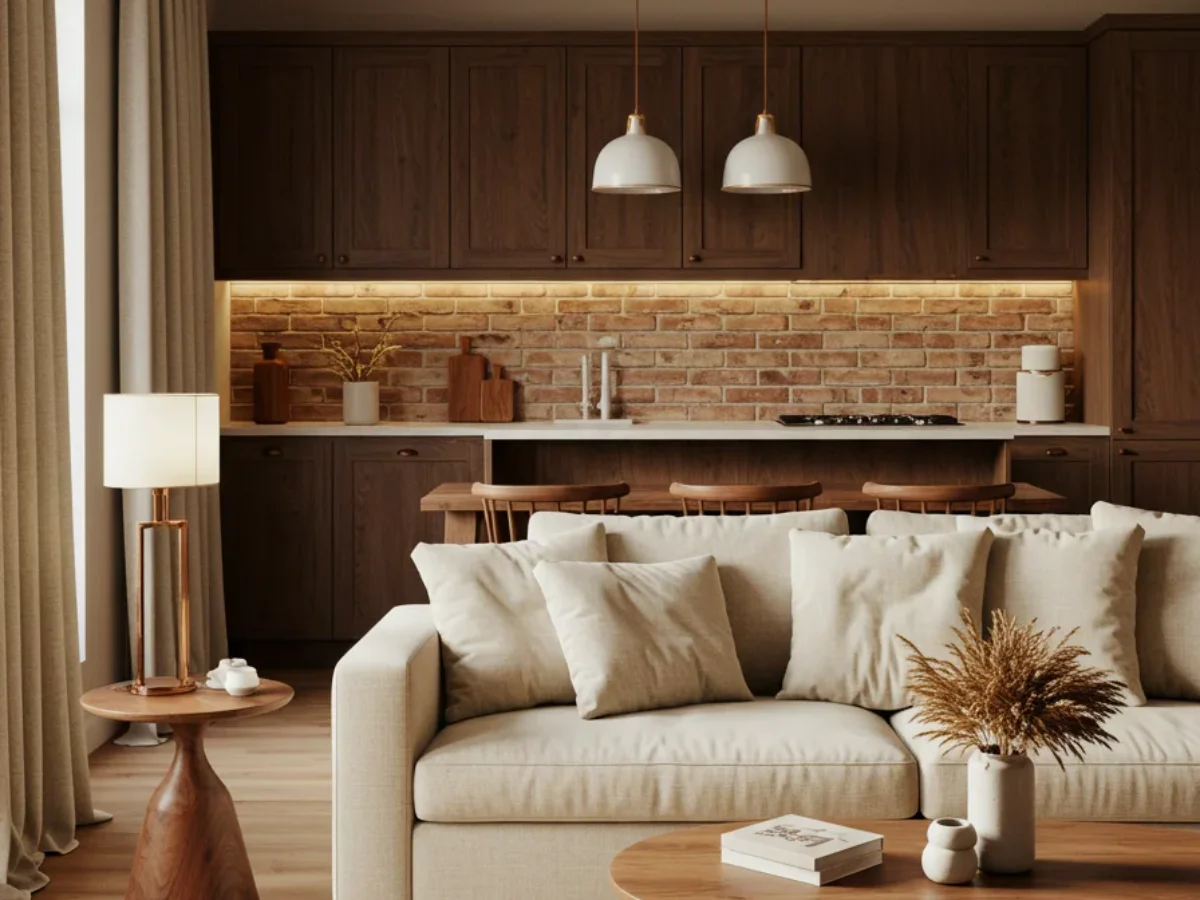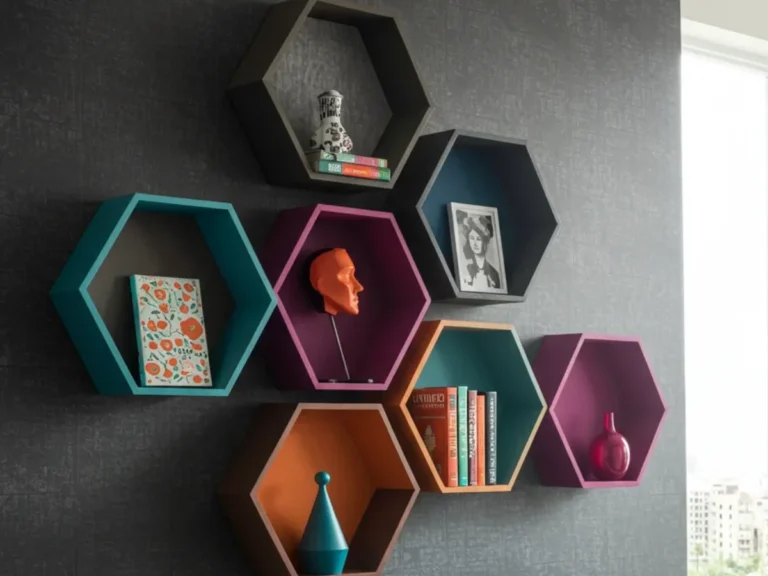27+ Inspiring Rustic Living Room and Kitchen Designs for a Cozy Home

Transform your home into a cozy retreat with these 27+ inspiring rustic living room and kitchen designs. Rustic style has a unique way of making any space feel warm and inviting, offering a timeless appeal that never goes out of fashion. Whether you are drawn to the natural beauty of exposed wooden beams, the charm of weathered furniture, or the understated elegance of neutral, earthy tones, these designs allow you to create a home that is both stylish and comfortable. Rustic interiors celebrate the beauty of natural materials and simple, functional decor, making every corner feel intentional and welcoming.
Incorporating stone accents, industrial lighting, and vintage finds adds layers of texture and character to your living spaces. These elements work together to create a home that is not only visually appealing but also highly functional. Open-concept layouts provide a sense of spaciousness, while farmhouse-inspired touches—like barn doors or wooden countertops—bring a nostalgic and homey feel. Thoughtful placement of furniture and decor ensures that each room has a sense of harmony and balance.
Adding small details can transform a room from ordinary to extraordinary. Greenery, woven baskets, and cozy textiles introduce softness and warmth, while a wood-burning stove or fireplace serves as a striking centerpiece that enhances the rustic vibe. Mixing old and new pieces creates an eclectic yet cohesive look, reflecting both personality and practicality. These little touches can make a significant difference in creating a home that feels lived-in, welcoming, and full of charm.
Ultimately, rustic design is about embracing authenticity and comfort. It allows homeowners to create spaces that are not only visually pleasing but also deeply personal and inviting. From kitchens that inspire culinary creativity to living rooms that encourage relaxation, these 27+ rustic design ideas offer endless possibilities for transforming your home. By combining natural materials, thoughtful accents, and warm colors, you can cultivate a retreat-like atmosphere that feels timeless, cozy, and completely your own.
Cozy wood tones
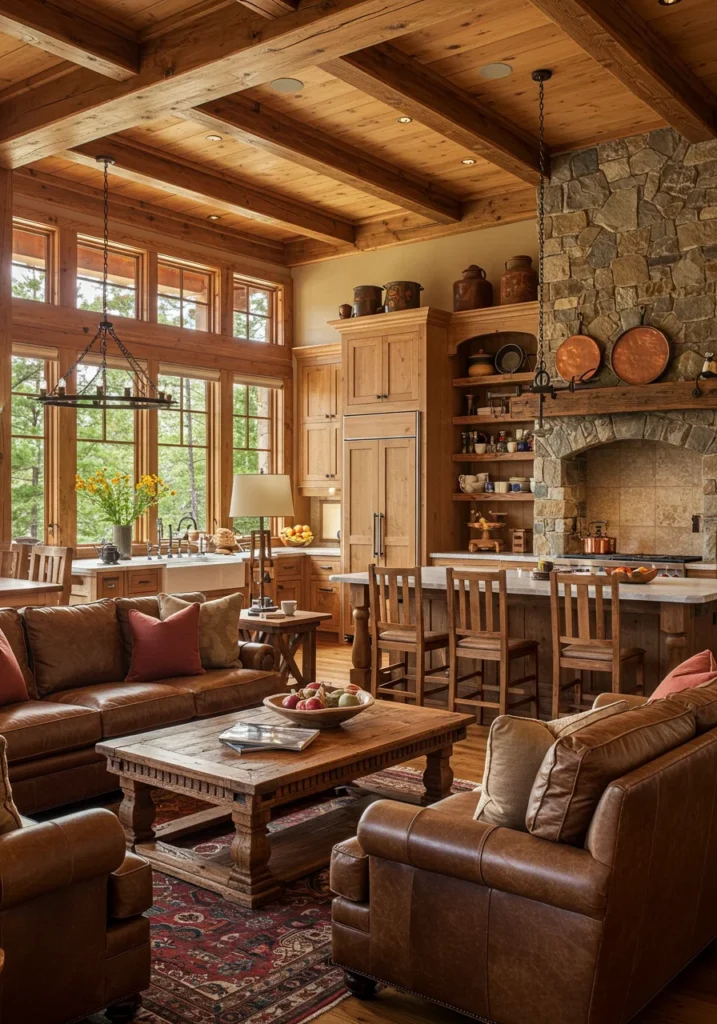
Cozy wood tones are a hallmark of rustic design, bringing warmth and character to living rooms and kitchens alike. They create a welcoming atmosphere that instantly makes a home feel inviting. Deep, rich shades such as oak, walnut, and cherry add a sense of depth and sophistication, giving spaces a grounded and timeless appeal. These darker tones work beautifully in larger furniture pieces, cabinetry, or accent walls, offering a strong focal point while still maintaining a natural, earthy feel.
Lighter woods, including pine, birch, or maple, keep a room feeling airy and open, balancing the richness of darker hues. They are ideal for flooring, shelving, or smaller furniture pieces, ensuring that spaces don’t feel heavy or closed-in. The versatility of wood tones allows them to blend seamlessly with other rustic elements such as stone surfaces, metal fixtures, and neutral fabrics, creating harmony throughout the home.
For a more authentic, lived-in look, incorporating reclaimed or weathered wood adds texture and history to your interior. Polished wood finishes, on the other hand, provide a refined rustic aesthetic that feels elegant yet still warm. Mixing textures—from rough-hewn beams to smooth tabletops—adds dimension and tactile interest, enhancing the cozy appeal of the space.
Layering wood tones—combining light and dark shades—creates visual depth without overwhelming the room. This thoughtful approach ensures that every element complements the other, producing a balanced, inviting environment. Whether used in cabinetry, flooring, or accent furniture, wood tones provide a timeless foundation for rustic living, making any home feel warm, comfortable, and full of character.
Exposed beams shine

Exposed beams are one of the most distinctive features of rustic design, instantly adding charm and character to both living rooms and kitchens. Their natural beauty draws the eye upward, emphasizing the architectural interest of a space while highlighting the warmth of wood. Whether beams are left raw, lightly stained, or painted, they introduce texture and depth that transforms a room from ordinary to inviting. These striking elements often become focal points, anchoring the overall design while showcasing craftsmanship and attention to detail.
In living rooms, exposed beams create a sense of coziness and structure, especially when combined with warm, comfortable furniture and natural textures like woven rugs, linen upholstery, or leather accents. They help frame the space and give it a grounded, welcoming feel, making it ideal for gatherings or quiet relaxation. Their presence adds vertical interest and a sense of continuity, connecting the ceiling to other rustic elements throughout the room.
Kitchens also benefit from the inclusion of exposed beams. They pair beautifully with open shelving, stone countertops, or industrial-style pendant lighting, creating a cohesive rustic-industrial vibe. The beams can visually delineate areas in an open-concept layout while complementing the warmth of wooden cabinetry and furniture, adding both style and practicality.
Ultimately, exposed beams offer a perfect balance of form and function. They not only enhance the visual appeal of a space but also emphasize the timeless, inviting nature of rustic interiors. Whether left raw or finished, beams provide a signature touch that makes any living room or kitchen feel thoughtfully designed, cozy, and full of enduring charm.
Vintage charm pieces

Vintage charm pieces are a wonderful way to infuse living rooms and kitchens with personality, warmth, and a sense of history. These carefully chosen items bring character to a space, making it feel lived-in and thoughtfully curated. Whether it’s an antique clock, a distressed cabinet, or retro-inspired cookware, each piece carries a story, evoking nostalgia while adding visual interest. Incorporating these elements allows homeowners to blend the past with the present, creating interiors that feel rich and meaningful.
In living rooms, vintage furniture such as a worn leather armchair, a reclaimed wood coffee table, or a tufted settee complements rustic decor beautifully. These pieces add texture and history, enhancing the cozy, inviting atmosphere of the space. Pairing them with natural textiles, wooden accents, and warm lighting ensures that the room feels harmonious while highlighting the charm of each vintage item.
Kitchens also benefit from vintage touches. Enamelware, old-fashioned scales, or a farmhouse hutch bring a sense of timeless charm, reminding us of simpler days while remaining practical. These pieces can act as focal points or functional decor, bridging rustic design elements with modern conveniences. They enrich the kitchen with character, making it feel welcoming and full of life.
The key to incorporating vintage items is balance. Mixing these unique finds with contemporary furniture, clean lines, and neutral colors prevents the space from feeling dated or cluttered. By thoughtfully combining old and new, you create a home that is both functional and full of personality, where every piece tells a story and every corner exudes charm.
Soft earthy hues
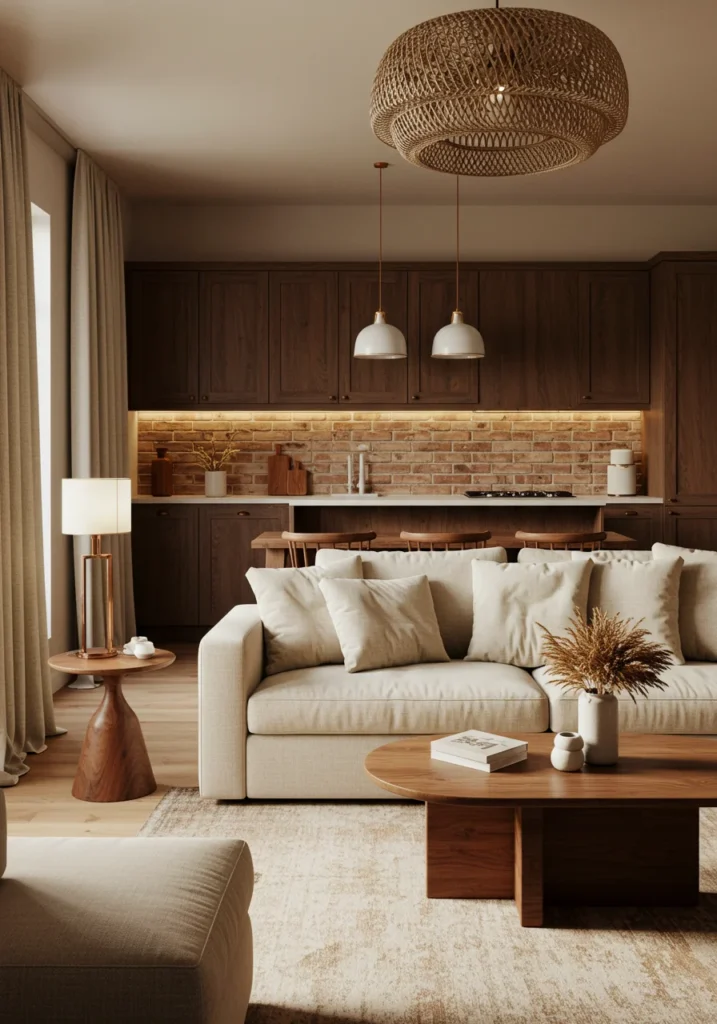
Soft earthy hues are an essential component of rustic design, bringing a sense of calm and warmth to living rooms and kitchens. These colors create an inviting atmosphere that feels grounded and soothing, encouraging relaxation and comfort. Shades such as beige, taupe, terracotta, and sage green evoke the natural world, connecting the indoors with the organic beauty of the outdoors. Using these colors thoughtfully allows rooms to feel harmonious, serene, and timeless, perfectly complementing the textures and materials found in rustic interiors.
In living rooms, earthy tones work beautifully on walls, rugs, cushions, and upholstery. They provide a neutral but warm backdrop that highlights rustic furniture, vintage accents, and wooden beams. These colors enhance the cozy, welcoming vibe of the space without overpowering it, creating a balanced environment where textures and details can shine. Combining different earthy shades in soft layers adds depth while maintaining a relaxed, cohesive aesthetic.
Kitchens also benefit from the subtle sophistication of earthy hues. Cabinets, backsplashes, or open shelving painted in muted greens, warm taupes, or soft terracotta can enhance rustic charm while remaining understated. These colors allow natural wood, stone countertops, and metal fixtures to stand out, creating a layered, visually interesting space that feels both functional and inviting.
The versatility of soft earthy tones ensures that rustic interiors feel cohesive and effortlessly cozy. Their muted nature makes them a perfect partner for vintage pieces, textured fabrics, and natural accents, tying together every element of the room. By embracing these calming shades, homeowners can cultivate spaces that are warm, welcoming, and timeless, offering a true retreat-like atmosphere in both living rooms and kitchens.
Rustic stone accents
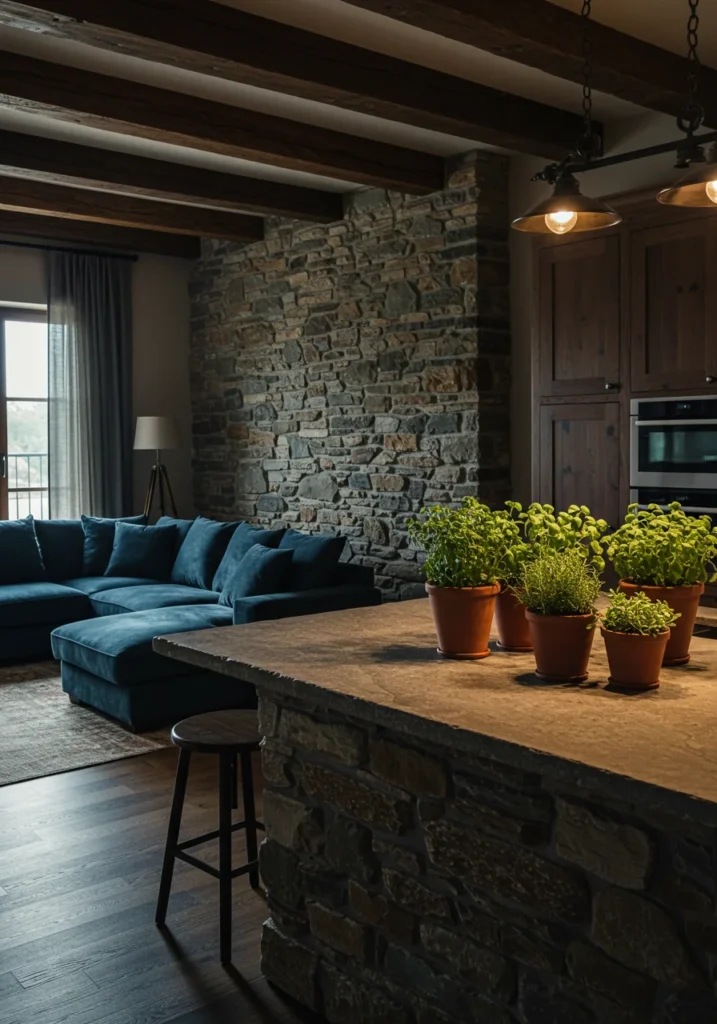
Rustic stone accents are a powerful way to bring natural beauty and timeless charm to both living rooms and kitchens. These features introduce texture, depth, and an organic warmth that immediately makes a space feel grounded and inviting. Whether it’s a stone fireplace, a textured backsplash, or a statement wall, the presence of natural stone evokes the outdoors while adding a touch of rustic elegance. Each piece has its own character, from rough-hewn surfaces to smooth, polished finishes, creating visual interest and a sense of authenticity.
In living rooms, stone accents often serve as the centerpiece of the design. A rough-hewn stone fireplace, for example, draws the eye and provides a cozy focal point around which furniture, rugs, and accessories can be arranged. The natural variations in color and texture add depth, enhancing the warm and welcoming atmosphere. Combined with wooden beams, soft textiles, and vintage furniture, stone elements help create a space that feels both timeless and lived-in.
Kitchens benefit equally from the inclusion of stone. Backsplashes, countertops, or even accent walls crafted from natural stone provide durability while maintaining rustic charm. The tactile nature of stone pairs beautifully with wooden cabinetry, metal fixtures, and neutral or earthy color palettes. These combinations balance ruggedness with refinement, ensuring the kitchen is practical yet visually captivating.
Ultimately, rustic stone accents celebrate raw, natural materials and connect interior spaces to the beauty of the outdoors. By integrating stone thoughtfully, homeowners can craft living rooms and kitchens that feel authentic, cozy, and effortlessly inviting. Whether used sparingly or as a dramatic focal point, stone adds character, texture, and a timeless charm that enhances the overall warmth of any rustic interior.
Open shelving style

Open shelving is a versatile design element that brings both functionality and rustic charm to living rooms and kitchens. It allows homeowners to showcase their favorite items—whether vintage dishes, cookbooks, or decorative pieces—while keeping them within easy reach. Unlike closed cabinetry, open shelving emphasizes accessibility and display, making everyday objects part of the room’s aesthetic. This approach not only adds practicality but also enhances the warmth and personality of a space, reflecting the homeowner’s style and interests.
In kitchens, open shelves pair beautifully with natural wood or metal brackets, reinforcing rustic and farmhouse aesthetics. They provide a perfect platform for displaying essentials in an organized yet stylish manner. Glass jars, enamelware, and ceramic bowls can become visual focal points, while the open arrangement keeps the kitchen feeling light and airy. Layering items by height and texture adds dimension, ensuring the shelves are both practical and visually appealing.
In living rooms, open shelving offers a charming way to showcase books, plants, and personal treasures. By mixing decorative objects with functional storage, these shelves create a cozy, curated look that reflects the personality of the homeowner. They also help break up wall space, adding visual interest without overwhelming the room, making even smaller spaces feel open and inviting.
The simplicity of open shelving allows both the materials and the displayed items to shine. It is a design choice that effortlessly balances style and practicality, complementing rustic interiors while remaining adaptable to modern or traditional designs. With open shelving, every item becomes part of the décor, contributing to a home that is organized, welcoming, and full of character.
Farmhouse sink focus

A farmhouse sink is a quintessential feature in rustic kitchens, instantly adding character and charm while remaining highly practical. Its deep, wide basin is ideal for tackling everyday kitchen tasks, from washing large pots and pans to preparing meals, making it both functional and stylish. The signature apron-front design exudes timeless elegance, serving as a focal point that draws the eye and anchors the surrounding cabinetry and countertops. Its presence elevates the overall aesthetic, blending seamlessly with the warmth and texture typical of rustic interiors.
Farmhouse sinks are commonly crafted from durable materials such as porcelain, fireclay, or stainless steel, each offering a unique combination of beauty and resilience. Porcelain and fireclay provide a classic, slightly glossy finish that enhances a vintage or farmhouse-inspired kitchen, while stainless steel offers a modern twist without losing rustic appeal. These materials are not only visually striking but also built to withstand the rigors of daily use, making them a practical choice for busy households.
The farmhouse sink pairs beautifully with a variety of surfaces and finishes. Wooden countertops, stone backsplashes, and vintage-style fixtures complement its rustic charm, while distressed cabinets or modern accents provide contrast and interest. By combining natural materials and thoughtful design, the sink becomes a cohesive element that ties together the kitchen’s overall style.
Ultimately, a farmhouse sink is more than just a functional appliance—it’s a statement piece that enhances both the aesthetics and usability of a rustic kitchen. It brings warmth, durability, and timeless charm, creating a welcoming and practical focal point that makes daily tasks more enjoyable while reinforcing the overall rustic design vision.
Woven basket storage
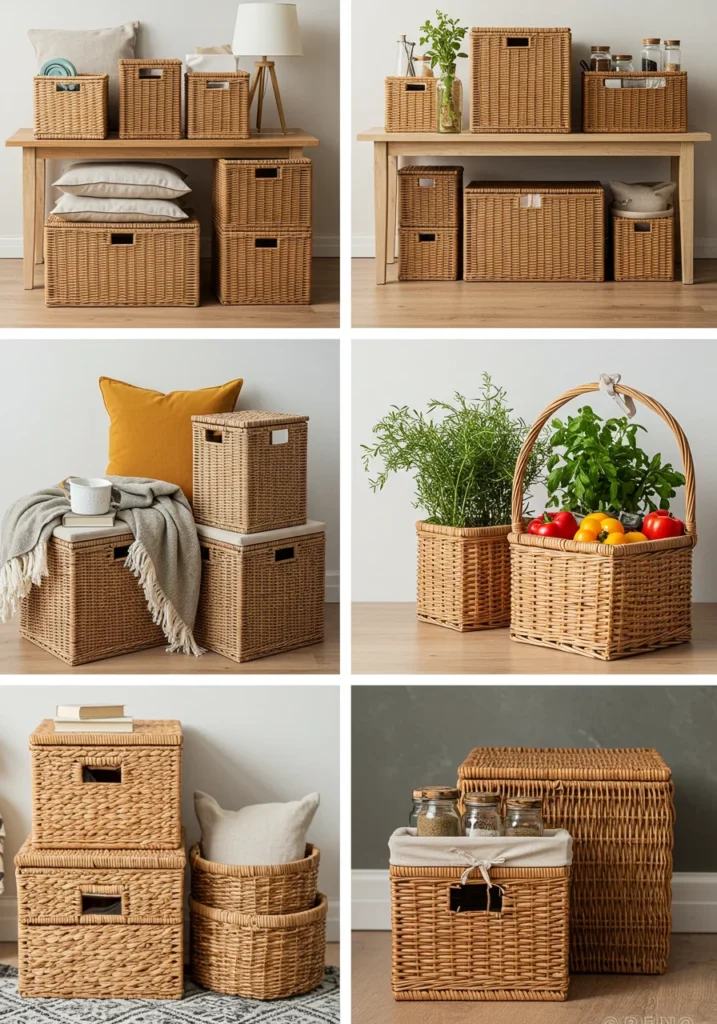
Woven basket storage is a simple yet effective way to bring both style and organization to living rooms and kitchens. These versatile pieces provide practical storage solutions while adding a touch of rustic charm, helping to keep spaces tidy without sacrificing aesthetics. Their natural textures and earthy tones make them a perfect complement to wooden furniture, stone accents, and neutral color palettes, enhancing the warm and inviting atmosphere that defines rustic interiors.
In living rooms, woven baskets can be used to store blankets, throw pillows, or magazines, keeping essentials close at hand while reducing clutter. Placed near seating areas, they add texture and visual interest, creating a cozy, lived-in feel. Larger baskets can serve as decorative floor accents, while smaller ones fit neatly on shelves or under tables, offering functional storage without overwhelming the space.
In kitchens, these baskets are equally practical. They can hold fresh produce, utensils, or pantry items, providing accessible storage that still feels natural and stylish. Grouped on open shelving or tucked under counters, woven baskets help maintain organization while contributing to the room’s rustic charm. Their organic materials soften the harder lines of cabinetry and countertops, creating balance and warmth.
Beyond their practicality, woven baskets bring an authentic, handcrafted quality to interiors. They highlight the beauty of natural materials, complementing wood tones, stone, and other rustic elements. By combining function and aesthetic appeal, woven basket storage ensures your living room or kitchen remains both organized and welcoming, adding texture, warmth, and timeless style to every corner.
Industrial lighting mix
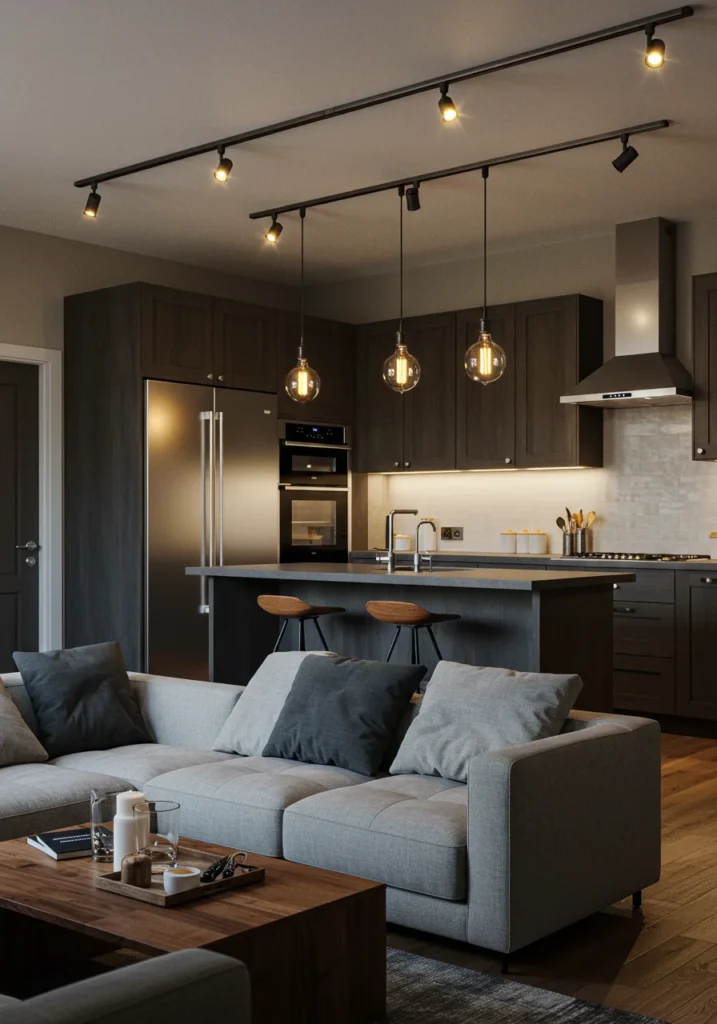
Industrial lighting is a striking way to introduce both boldness and rustic charm to living rooms and kitchens. With materials like metal, iron, or brass, these fixtures bring a touch of raw, utilitarian elegance that contrasts beautifully with natural elements such as wood and stone. Their distinctive designs make them not only functional but also focal points that enhance the overall character of a space. Industrial lighting bridges the gap between rugged, vintage appeal and contemporary style, making it a versatile choice for a variety of rustic interiors.
Pendant lights are a popular choice in kitchens, where they can hang above islands or dining areas, providing targeted illumination while adding visual interest. Edison bulbs, with their exposed filaments, emit a warm, inviting glow that complements the cozy atmosphere typical of rustic designs. Cage-style fixtures add texture and structure, turning lighting into a decorative feature as well as a practical one. These elements work together to highlight architectural details like wooden beams or stone backsplashes, enhancing the layered, tactile feel of the room.
In living rooms, industrial lighting serves both functional and aesthetic purposes. Floor lamps, chandeliers, or wall sconces made from metal or iron create dramatic contrasts against softer materials like textiles, woven baskets, and upholstered furniture. The combination of warmth from the light and the cool, sturdy materials of the fixtures results in a balanced, welcoming environment that is both stylish and practical.
Ultimately, industrial lighting adds depth, warmth, and personality to rustic interiors. By thoughtfully incorporating these fixtures, homeowners can enhance the cozy, lived-in vibe of their spaces while introducing bold design elements that elevate the overall aesthetic. With the right mix of materials, styles, and placements, industrial lighting becomes a timeless and eye-catching addition to any living room or kitchen.
Greenery for warmth
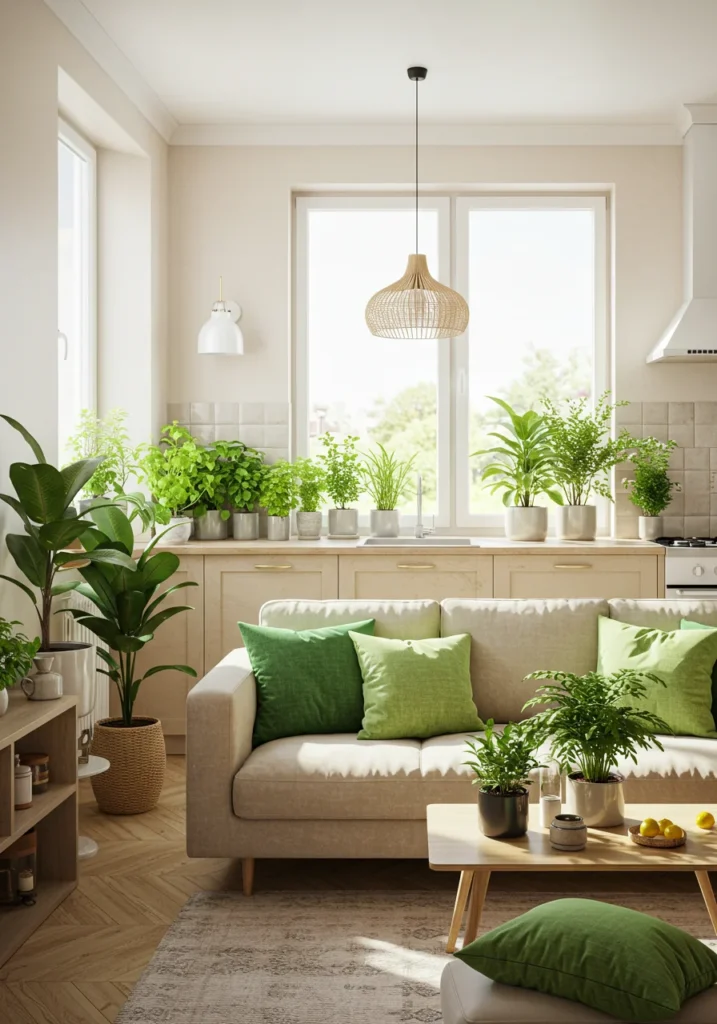
Adding greenery is one of the simplest and most effective ways to bring warmth, life, and freshness to living rooms and kitchens. Plants introduce color, texture, and a sense of vitality, making spaces feel inviting and well cared for. From potted plants on the floor to hanging vines cascading from shelves or ceiling hooks, greenery can transform even the most neutral or rustic interiors into vibrant, welcoming spaces. The natural beauty of plants enhances the overall atmosphere, creating a calm, restorative environment.
In living rooms, greenery can be incorporated in a variety of ways. Large potted plants placed near seating areas or in corners add height and visual interest, while smaller plants on coffee tables, mantels, or open shelving create layered, dynamic displays. Hanging planters or trailing vines soften hard architectural lines and bring an organic element to the room, balancing wood tones, stone accents, and metal fixtures. Plants also contribute to a cozy, lived-in feel, making the space both stylish and comfortable.
Kitchens benefit equally from greenery. Herb gardens on windowsills, small potted plants on counters, or trailing vines near shelves not only add aesthetic appeal but can also be functional. Fresh herbs enhance cooking while maintaining a natural, rustic charm. Greenery in kitchens complements wood cabinetry, stone countertops, and woven baskets, tying together textures and materials for a cohesive look.
Ultimately, plants are a versatile and timeless addition to rustic interiors. They introduce life, warmth, and color while harmonizing with wood tones, earthy hues, stone accents, and other natural materials. By thoughtfully incorporating greenery, homeowners can enhance the cozy, organic vibe of their living rooms and kitchens, creating spaces that feel fresh, inviting, and connected to nature.
Brick backsplash glow
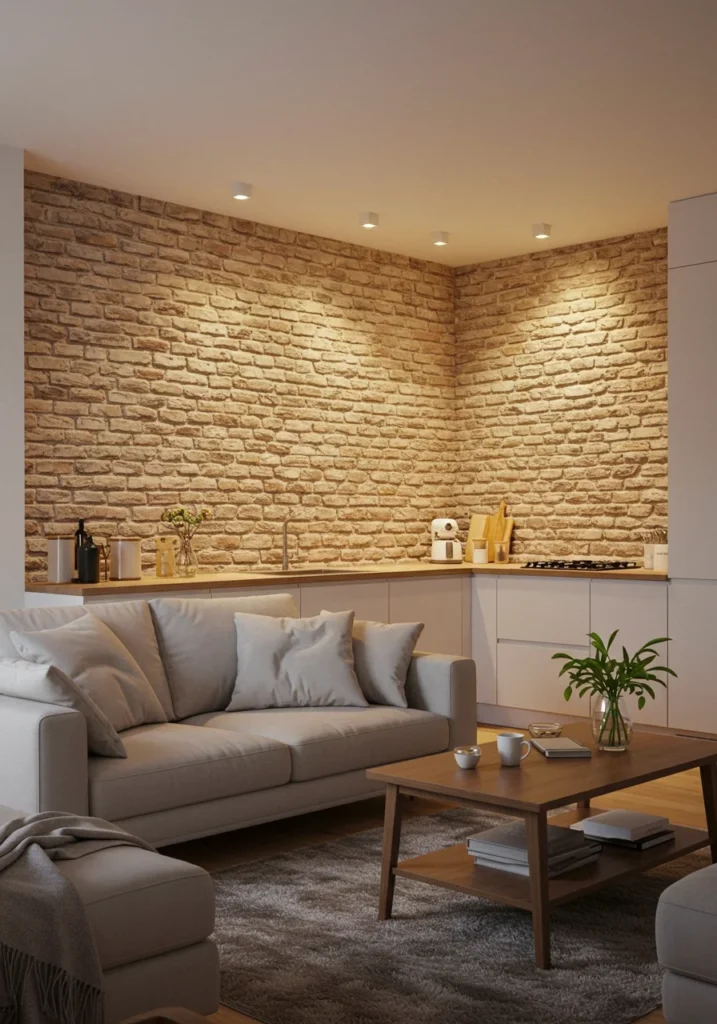
A brick backsplash is a classic way to infuse rustic warmth and texture into any kitchen. Its natural, earthy tones immediately create a cozy and inviting atmosphere, making the space feel lived-in and timeless. Unlike smooth or uniform surfaces, brick offers unique texture and visual interest, adding depth and character to the room. Whether left in its natural red hue, painted, or whitewashed for a softer look, a brick backsplash brings a tactile, authentic quality that enhances the overall rustic aesthetic.
In kitchens, brick backsplashes serve as both a functional and decorative element. They protect walls from cooking splatters while providing a striking backdrop for cabinetry, countertops, and appliances. The textured surface draws the eye and creates a focal point, particularly when paired with wooden cabinets, stone countertops, or industrial lighting. Brick’s versatility allows it to complement a range of styles, from farmhouse and traditional to rustic-modern hybrids.
Different finishes of brick can evoke distinct moods in a kitchen. A natural brick wall emphasizes warmth and authenticity, while whitewashed or painted brick adds brightness and a slightly modern touch without sacrificing rustic charm. Layering brick with other natural materials, such as wood and metal, creates a balanced and visually dynamic space.
Ultimately, a brick backsplash adds depth, character, and warmth to rustic kitchens. Its timeless appeal and tactile texture make it a standout feature that elevates the design while maintaining practicality. By combining brick with complementary elements like wood cabinets, stone surfaces, and industrial lighting, homeowners can achieve a charming, cohesive kitchen that feels both functional and full of personality.
Reclaimed wood decor
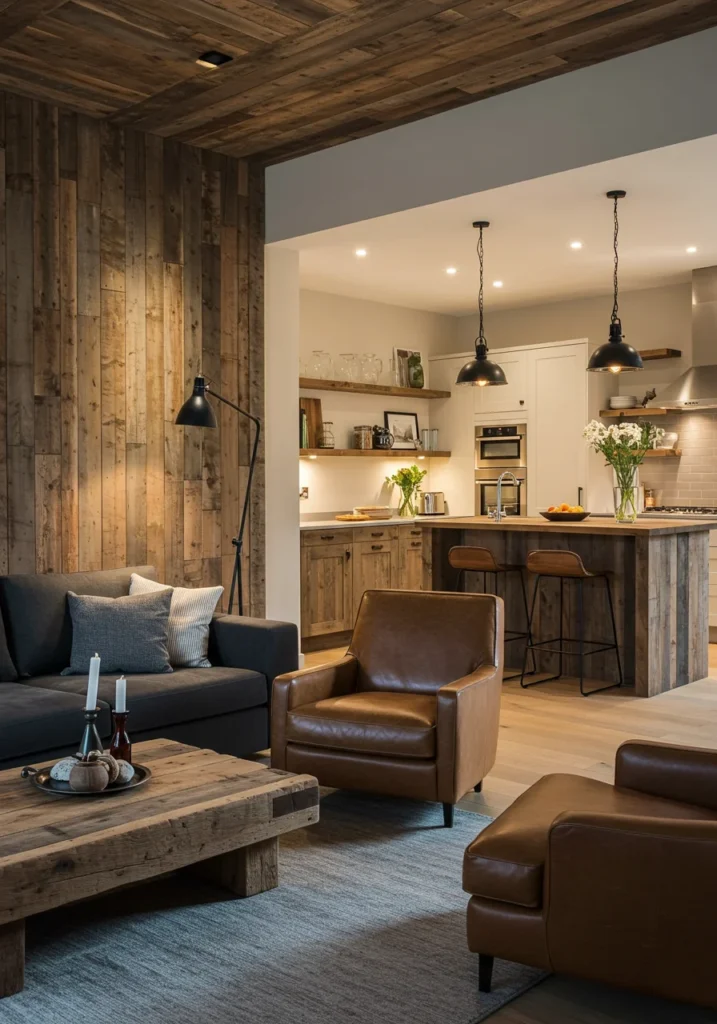
Reclaimed wood decor is a beautiful way to introduce rustic charm and sustainability into living rooms and kitchens. This material, often salvaged from old barns, factories, or homes, carries a sense of history and character, making each piece unique. Its weathered textures and distinct grain patterns tell a story, adding authenticity and warmth to any space. Incorporating reclaimed wood not only enhances the aesthetic but also promotes eco-friendly design by giving new life to materials that might otherwise go to waste.
In living rooms, reclaimed wood can be used in furniture, shelving, or accent walls, instantly creating a cozy, inviting atmosphere. A reclaimed wood coffee table or sideboard adds texture and visual interest, while wall panels or ceiling beams can provide architectural character. Pairing these elements with soft furnishings, woven textiles, and neutral tones ensures the space feels balanced and welcoming, while the natural imperfections in the wood add a sense of depth and personality.
Kitchens benefit equally from reclaimed wood decor. Cabinets, countertops, or open shelving crafted from salvaged wood provide a warm, lived-in feel that complements stone backsplashes, metal fixtures, and farmhouse sinks. The mix of textures—from the rough, weathered wood to smooth countertops—creates visual contrast and highlights the organic beauty of natural materials.
Ultimately, reclaimed wood decor brings both style and story to rustic interiors. Its timeless appeal, combined with sustainable practices, allows homeowners to craft living rooms and kitchens that feel authentic, cozy, and full of character. By thoughtfully incorporating this material, spaces become more inviting, layered, and connected to history, while maintaining a warm and timeless rustic aesthetic.
Copper touch accents

Copper accents are a stylish way to introduce warmth and elegance into living rooms and kitchens, seamlessly blending with rustic and farmhouse styles. This versatile material brings a rich, earthy tone that complements natural wood, stone, and neutral color palettes, adding depth and sophistication to any space. Copper’s warm hue naturally draws the eye, creating subtle highlights that enhance the overall aesthetic while maintaining a cozy, inviting atmosphere.
In living rooms, copper can be incorporated through decorative pieces such as vases, candleholders, or picture frames. These small touches add a refined yet rustic charm, tying together elements like exposed beams, woven textiles, and reclaimed wood furniture. The warm glow of copper accents contrasts beautifully with soft fabrics and earthy tones, creating a balanced, layered look that feels both elegant and lived-in.
Kitchens are an ideal space for showcasing copper as well. Copper light fixtures, cookware, and hardware bring a timeless appeal while remaining highly functional. Pendant lights or faucets in copper finish not only illuminate and accessorize the space but also add a vintage-inspired touch. Over time, copper develops a natural patina, which adds character and a sense of history, enhancing the room’s rustic aesthetic.
Ultimately, copper accents elevate the warmth, charm, and sophistication of any rustic interior. By thoughtfully incorporating copper through lighting, kitchenware, or decor, homeowners can create living rooms and kitchens that feel inviting, stylish, and full of personality. Its natural glow and evolving patina ensure that each space develops a unique character, blending timeless elegance with cozy, rustic charm.
Layered textures

Layered textures are essential for creating depth, warmth, and coziness in living rooms and kitchens, especially within rustic interiors. By thoughtfully combining materials of different textures, homeowners can craft spaces that feel inviting and lived-in. Layering adds visual interest and dimension, preventing a room from feeling flat or one-dimensional. This approach enhances the rustic vibe, highlighting natural materials while making the environment comfortable and stylish.
In living rooms, layered textures can be incorporated through rugs, throws, cushions, and curtains. A soft wool rug on a wooden floor anchors the seating area and adds warmth underfoot, while woven throws and linen cushions create tactile comfort. Linen curtains allow natural light to filter gently into the room, complementing wooden furniture and exposed beams. Mixing textures in this way balances softness with structure, making the space feel harmonious and welcoming.
Kitchens also benefit from layering textures. Wooden countertops and cabinetry can be paired with stone backsplashes, metal fixtures, and woven baskets, creating a rich, tactile environment. Natural fibers and textured ceramics on open shelving further contribute to the rustic aesthetic while remaining functional and stylish. By thoughtfully combining these elements, the kitchen feels warm, inviting, and full of character.
Ultimately, layering textures is a key strategy for achieving a cozy, rustic atmosphere. Mixing soft fabrics, natural fibers, stone, metal, and wood not only adds visual interest but also enhances the sensory experience of a space. Layered textures make living rooms and kitchens feel dynamic, warm, and inviting, ensuring that each element works together to create a balanced and timeless rustic interior.
Wood stove cozy enterpiece
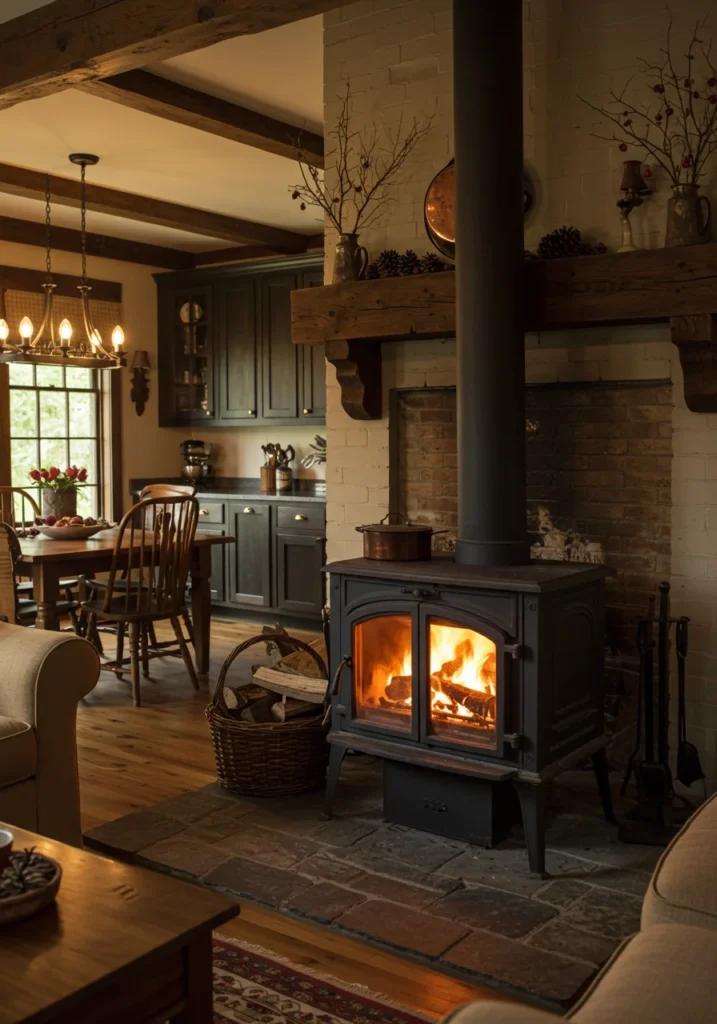
A wood stove is a quintessential feature in rustic living rooms and kitchens, serving as both a functional heating source and a cozy focal point. Its presence instantly adds warmth and charm to any space, creating an inviting atmosphere where family and friends naturally gather. The classic design of a wood stove evokes nostalgia while seamlessly blending with modern rustic interiors, making it a timeless addition to your home.
In living rooms, a wood stove can anchor the space, providing a central point around which furniture and decor are arranged. Surrounding the stove with stone accents, such as a hearth or a textured wall, enhances its visual impact and emphasizes the natural, earthy feel of the room. Pairing it with wooden beams, furniture, and woven textiles further contributes to the cozy, lived-in ambiance that defines rustic interiors.
Kitchens also benefit from the warmth and character a wood stove brings. Placed strategically, it can complement wood cabinetry, stone countertops, and rustic shelving, creating a harmonious blend of function and style. Beyond heating, the stove serves as a visual anchor, balancing the room’s design elements while maintaining practicality for everyday use.
Ultimately, a wood stove combines functionality, style, and rustic appeal in one elegant package. By radiating warmth and serving as a natural centerpiece, it enhances the inviting atmosphere of living rooms and kitchens alike. Its timeless charm, paired with stone, wood, and other natural materials, ensures that the space feels both cozy and visually captivating, embodying the essence of rustic living.
Distressed cabinet finish
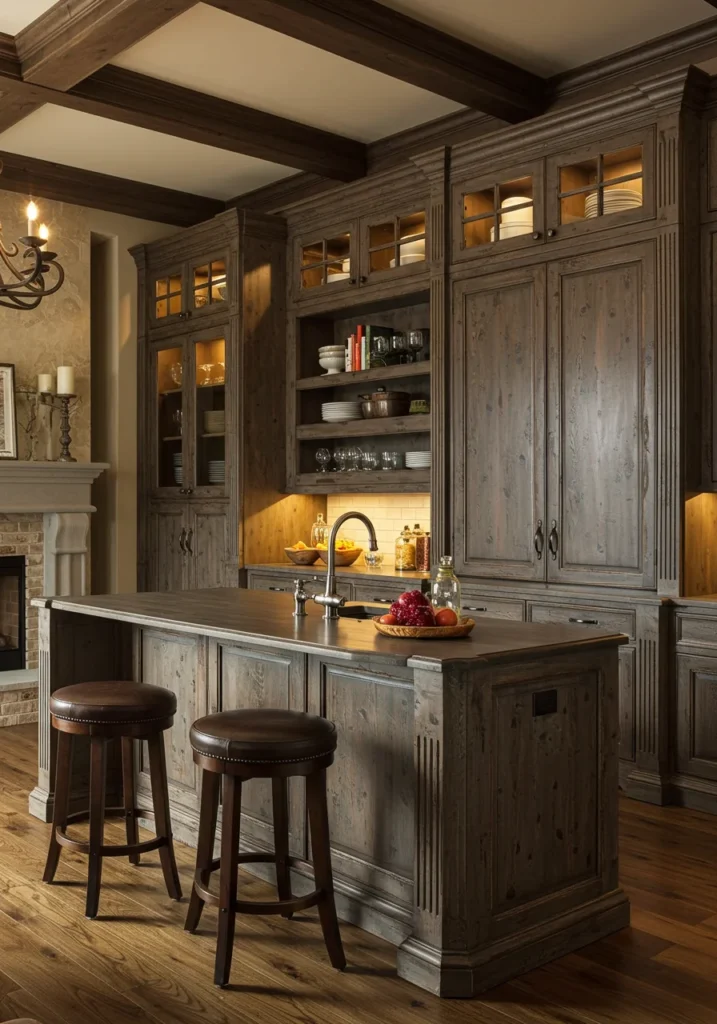
A distressed cabinet finish is a classic way to introduce rustic charm and character into kitchens and living spaces. Its intentionally weathered appearance, featuring chipped paint, worn edges, or faded surfaces, evokes a sense of history and authenticity. These cabinets instantly create a cozy, lived-in atmosphere, making rooms feel warm, inviting, and full of personality. Unlike pristine, modern finishes, distressed cabinets bring texture and depth to the space, highlighting the beauty of imperfection and natural materials.
In kitchens, distressed cabinets can serve as a focal point, complementing stone countertops, wood countertops, or open shelving. The worn finish pairs beautifully with vintage-inspired hardware, farmhouse sinks, and copper accents, creating a balanced look that is both functional and aesthetically pleasing. Their weathered surfaces harmonize with earthy hues and layered textures, enhancing the rustic vibe while remaining practical for everyday use.
In living rooms or dining areas, distressed cabinetry can be incorporated through storage pieces, sideboards, or display units. These pieces provide both functionality and visual interest, offering space for books, decor, or kitchenware while contributing to the room’s timeless charm. The combination of distressed finishes with reclaimed wood, woven baskets, and industrial lighting adds warmth and depth, making the space feel carefully curated and cozy.
Ultimately, distressed cabinets offer a versatile and enduring design element. By pairing them with natural materials, vintage accents, and layered textures, homeowners can create kitchens and living spaces that are both practical and full of rustic personality. Their weathered, lived-in look ensures a timeless appeal, adding character and warmth to every corner of the home.
Earthy rugs pop

Earthy rugs are an essential element for adding warmth, texture, and character to living rooms and kitchens. Their natural tones—ranging from soft beiges and warm browns to muted greens and terracotta—help ground a space, creating a cozy and inviting atmosphere. By incorporating an earthy rug, homeowners can tie together wood, stone, and other natural materials, creating a cohesive and harmonious rustic interior. Rugs also introduce a soft, tactile layer that contrasts with harder surfaces like wooden floors or stone countertops, enhancing the comfort of the room.
Patterns inspired by nature, such as muted florals, geometric designs, or subtle tribal motifs, add visual interest without overwhelming the space. These designs can highlight the rustic charm of other elements in the room, such as exposed beams, reclaimed wood furniture, or stone accents. Whether used as a centerpiece under a coffee table or layered in front of a kitchen island, an earthy rug creates a warm, inviting focal point that draws people into the space.
In kitchens, rugs offer both style and practicality. A durable, natural-fiber rug can define work zones, provide comfort underfoot while cooking, and complement rustic cabinetry, stone backsplashes, or wood countertops. In living rooms, rugs anchor seating areas, soften furniture edges, and create a sense of intimacy in open-concept layouts. Layering rugs with throws, cushions, and woven baskets further enhances the room’s depth and cozy appeal.
Ultimately, earthy rugs are a versatile and timeless addition to rustic interiors. Their natural colors, patterns, and textures complement wood, stone, metal, and other organic elements, creating a balanced, warm, and welcoming environment. By incorporating an earthy rug, homeowners can effortlessly enhance the style, comfort, and character of both living rooms and kitchens, making these spaces feel inviting and full of personality.
Mismatched furniture flair
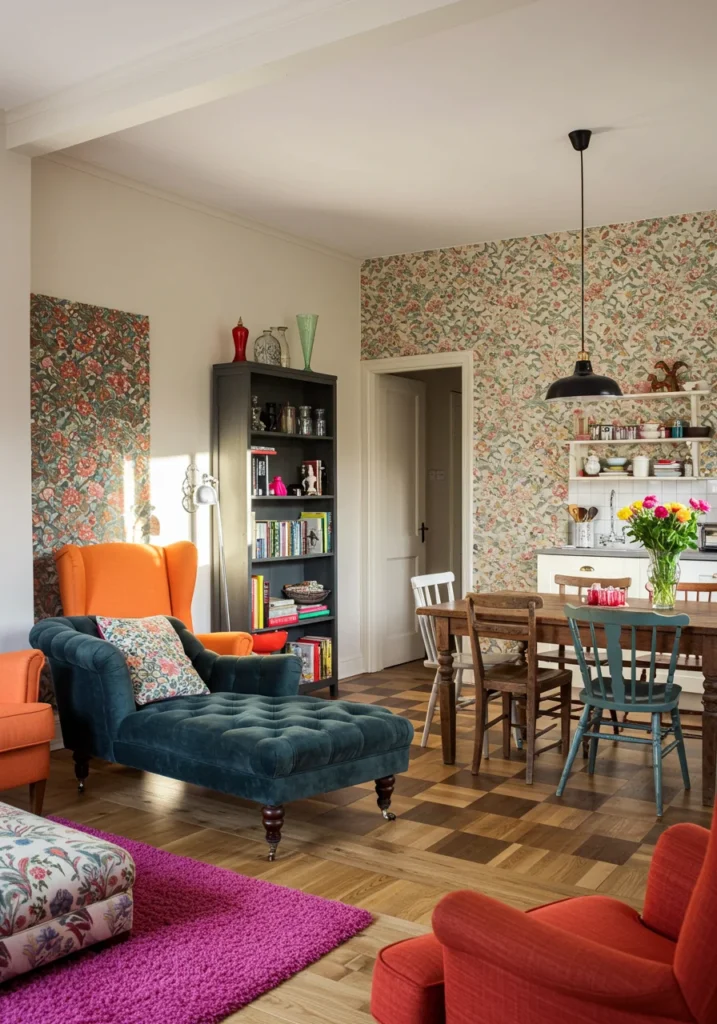
Mismatched furniture is a creative way to introduce personality, charm, and visual interest into living rooms and kitchens. By intentionally combining pieces of different styles, finishes, or colors, homeowners can create a casual, lived-in vibe that feels authentic and approachable. This design strategy breaks away from uniformity, allowing each furniture piece to tell its own story while contributing to the overall aesthetic. The resulting eclectic mix feels dynamic and personal, perfectly complementing rustic interiors, which thrive on warmth, texture, and character.
In living rooms, mismatched seating—such as a leather armchair paired with a slipcovered sofa or a wooden rocking chair alongside an upholstered bench—adds layers of texture and interest. Side tables, coffee tables, and storage units in varying finishes or wood tones contribute to a relaxed, curated feel. This approach allows homeowners to blend vintage pieces, reclaimed wood furniture, and contemporary accents seamlessly, creating spaces that are functional yet visually stimulating.
Kitchens benefit from mismatched elements as well. Chairs, barstools, and dining tables in different styles or colors can infuse energy and charm, transforming a utilitarian space into a welcoming hub. Pairing these pieces with rustic cabinetry, open shelving, and natural materials ensures that the overall look remains cohesive while embracing individuality.
Ultimately, mismatched furniture adds depth, warmth, and personality to any space. By thoughtfully combining different finishes, colors, and styles, homeowners can create living rooms and kitchens that feel eclectic, inviting, and full of rustic charm. This design approach highlights creativity and comfort, resulting in spaces that are both visually engaging and authentically lived-in.
Rustic pottery details
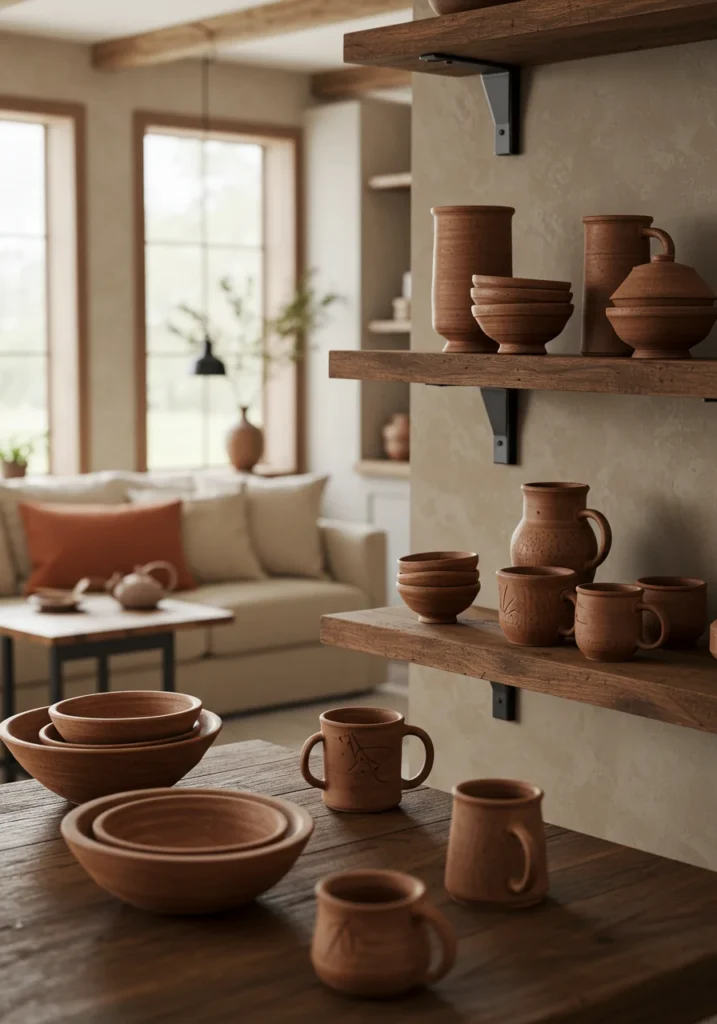
Rustic pottery is a timeless way to introduce charm, texture, and authenticity into living rooms and kitchens. Its earthy tones and handcrafted appeal bring warmth and personality to any space, making it feel welcoming and thoughtfully curated. Each piece tells a story through its unique shape, glaze, and imperfections, reflecting the artisan’s craftsmanship and enhancing the rustic aesthetic. Unlike mass-produced items, rustic pottery adds character and a sense of individuality, elevating both décor and functional spaces.
In living rooms, rustic pottery can be displayed as decorative accents on shelves, mantels, or coffee tables. Vases, bowls, and planters bring tactile interest while complementing wood tones, woven baskets, and exposed beams. Layering pottery pieces of different sizes, shapes, and finishes creates visual depth and contributes to a cozy, lived-in feel. Their natural textures harmonize beautifully with other rustic elements, tying together the overall design of the room.
Kitchens benefit equally from rustic pottery, whether used for serving or as functional décor. Earthenware bowls, ceramic pitchers, or handmade mugs add warmth to countertops, open shelving, or dining tables. These pieces not only serve a practical purpose but also enhance the visual and textural richness of the space, pairing seamlessly with wood cabinets, stone backsplashes, and farmhouse sinks.
Ultimately, rustic pottery is a versatile and timeless design element. Its handcrafted quality, earthy finishes, and organic imperfections make it a perfect complement to rustic and farmhouse styles, adding texture, warmth, and charm to both living rooms and kitchens. By incorporating these pieces, homeowners can create spaces that feel authentic, inviting, and full of personality.
Weathered wood appeal

Weathered wood is a quintessential element of rustic design, bringing timeless appeal, warmth, and character to living rooms and kitchens. Its natural textures and aged patina immediately create a sense of history and authenticity, making any space feel cozy and inviting. Unlike polished or uniform surfaces, weathered wood showcases the beauty of imperfection, from subtle cracks and knots to worn edges and unique grain patterns. These details add depth and personality, creating interiors that feel lived-in and thoughtfully curated.
In living rooms, weathered wood can be incorporated through furniture, flooring, or decorative accents. A reclaimed coffee table, sideboard, or shelving unit made from aged wood adds tactile interest and visual contrast to soft textiles, woven baskets, and upholstered seating. Flooring in weathered wood tones enhances the warmth of the space while anchoring the room’s overall design, providing a natural backdrop for layered textures and eclectic furnishings.
Kitchens also benefit from the warmth and character of weathered wood. Cabinets, open shelving, countertops, or even a kitchen island crafted from aged wood pair beautifully with stone backsplashes, metal fixtures, and earthy color palettes. These combinations create a balanced, inviting atmosphere that is both functional and visually appealing.
Ultimately, weathered wood is a versatile and enduring design element. Its rich textures, worn finishes, and natural imperfections complement stone, metal, and earthy tones, enhancing the rustic charm of living rooms and kitchens. By thoughtfully incorporating weathered wood, homeowners can create spaces that feel warm, authentic, and timeless, offering a cozy retreat that celebrates the beauty of natural materials.
Vintage-inspired decor
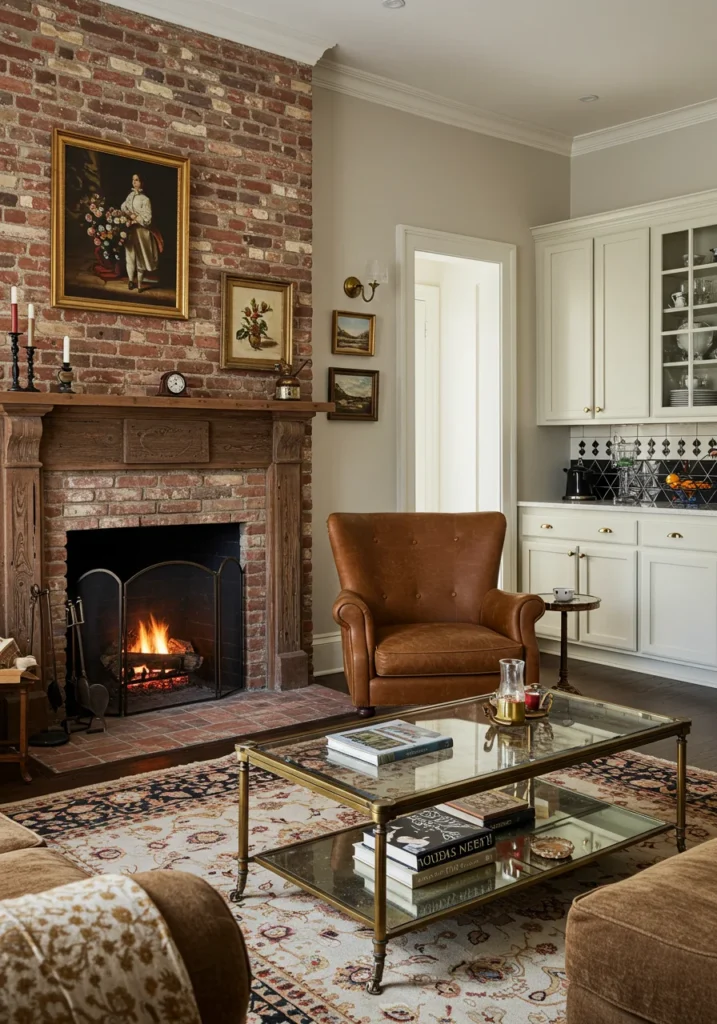
Vintage-inspired decor is a wonderful way to infuse living rooms and kitchens with charm, personality, and a sense of nostalgia. These pieces, whether antique clocks, retro signs, aged mirrors, or weathered trinkets, bring a timeless quality to any space. They add visual interest and a sense of history, making rooms feel thoughtfully curated and inviting. By incorporating vintage-inspired elements, homeowners can create interiors that tell a story while complementing the natural textures and materials typical of rustic design.
In living rooms, vintage decor works beautifully alongside rustic furnishings and layered textures. A weathered mirror above a reclaimed wood console, an antique clock on a mantel, or a retro-inspired sign on the wall adds character and focal points to the space. These pieces can contrast with modern furniture while harmonizing with wood tones, earthy textiles, and woven baskets, resulting in a balanced, lived-in feel.
Kitchens benefit equally from vintage-inspired accents. A farmhouse-style clock, retro signage, or aged canisters can elevate cabinetry, stone countertops, or open shelving, providing both functionality and visual charm. These nostalgic touches complement rustic elements such as exposed beams, brick backsplashes, and reclaimed wood furniture, tying the design together.
Ultimately, vintage-inspired decor adds warmth, personality, and a timeless appeal to rustic interiors. By thoughtfully blending nostalgic pieces with wood, stone, and muted tones, homeowners can create living rooms and kitchens that feel cozy, inviting, and full of character, celebrating both the past and the present.
Natural metal blends

Natural metal blends are a sophisticated way to introduce subtle elegance and rustic charm to living rooms and kitchens. Materials such as iron, brass, and copper add both visual interest and texture, complementing the warmth of wood and the earthy tones of stone. By incorporating these metals thoughtfully, homeowners can achieve a balanced look that feels both timeless and inviting, enhancing the overall rustic aesthetic without overwhelming the space.
In living rooms, natural metal accents can be incorporated through lighting fixtures, furniture hardware, or decorative elements. Iron floor lamps, brass side tables, or copper picture frames provide contrast against softer textiles, wooden beams, and earthy rugs. These metallic touches introduce a refined element while still maintaining the warmth and character that define rustic interiors. Their natural finishes harmonize with other materials, creating a layered, cohesive design that is visually engaging and comfortable.
Kitchens benefit equally from the use of natural metals. Copper faucets, iron cabinet handles, and brass pendant lighting can elevate the space while complementing wood cabinetry, stone countertops, and open shelving. These metals not only add a polished, functional element but also enhance the textural variety within the room, creating a harmonious balance between rustic charm and subtle sophistication.
Ultimately, natural metal blends offer versatility, durability, and timeless appeal in rustic interiors. By pairing iron, brass, or copper with wood, stone, and earthy textures, homeowners can craft living rooms and kitchens that feel warm, stylish, and layered. These metals add depth, elegance, and a touch of character, completing a rustic design that is both inviting and enduring.
Open, airy layouts

Open, airy layouts are a key design strategy for creating spacious, welcoming living rooms and kitchens. By blending these areas seamlessly, homes feel larger, brighter, and more connected, allowing natural light to flow freely throughout the space. This openness not only enhances the aesthetic appeal but also supports social interaction, making it ideal for family gatherings, entertaining guests, or simply enjoying a sense of freedom within the home.
In living rooms, open layouts allow furniture arrangements to feel less constrained, encouraging conversation and creating a more relaxed atmosphere. The absence of unnecessary walls or barriers ensures that architectural features such as exposed beams, stone accents, or large windows become focal points. Coupled with warm wood tones, layered textures, and cozy furnishings, these open spaces maintain the inviting, lived-in feel that defines rustic interiors.
Kitchens benefit from open layouts by fostering accessibility and functionality. Islands, breakfast bars, and strategically placed cabinetry can define zones without breaking the visual flow, while materials like wood, stone, and metal tie the design together. Natural light illuminates countertops, dining areas, and seating spaces, creating a cheerful and energizing environment.
Ultimately, open, airy layouts merge practicality with rustic charm. By combining seamless transitions between living and kitchen spaces with warm textures, natural materials, and cozy accents, homeowners can craft interiors that feel both expansive and intimate, welcoming, and full of character.
Stone countertop highlights
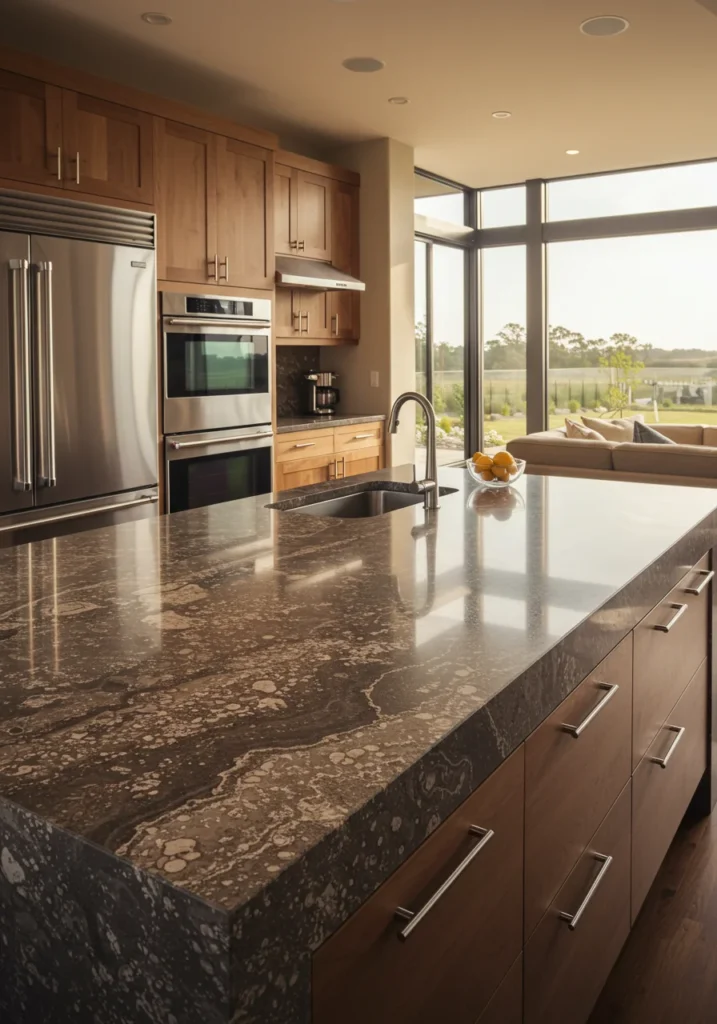
Stone countertops are a striking way to introduce natural beauty, durability, and rustic charm to kitchens. Materials such as granite, marble, or soapstone offer rich textures, earthy tones, and unique patterns that make each countertop one-of-a-kind. Their natural variations and depth create a visually engaging surface, adding both elegance and character to the kitchen. Stone countertops are not only aesthetically pleasing but also highly practical, providing a durable workspace for cooking, prep, and everyday use.
In rustic kitchens, stone countertops pair beautifully with wood cabinetry, complementing the warmth and organic textures of timber while enhancing the natural appeal of the space. The combination of stone and wood creates a timeless look, where the contrasting materials balance each other’s textures and colors. Layering in metal accents—such as faucets, handles, and lighting fixtures—further elevates the aesthetic, creating a harmonious mix of materials that is both functional and stylish.
Stone countertops also serve as a focal point, particularly when used with complementary features like brick backsplashes, reclaimed wood shelving, or copper accents. Their presence adds a sense of permanence and luxury to the kitchen while maintaining the cozy, lived-in feel that defines rustic design. The tactile nature of stone invites interaction, making the space feel grounded and welcoming.
Ultimately, stone countertops are a versatile and enduring design choice for rustic kitchens. By combining their natural beauty with wood, metal, and other organic materials, homeowners can create a timeless, elegant, and highly functional space. These surfaces bring depth, texture, and durability, ensuring the kitchen remains both practical and visually captivating for years to come.
Subtle rustic elegance
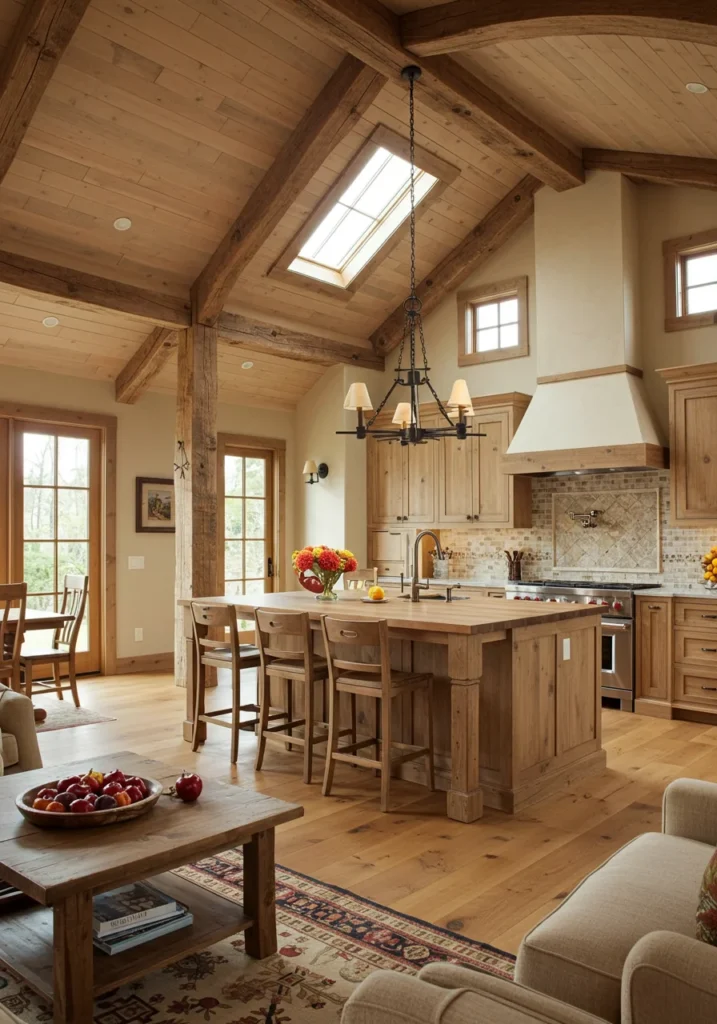
Subtle rustic elegance is a design approach that blends natural, organic elements with refined, understated touches to create living rooms and kitchens that feel both warm and sophisticated. This style emphasizes balance, highlighting the inherent beauty of materials such as soft wood, stone, and woven fibers while pairing them with clean lines and minimal decor. The result is a space that exudes rustic charm without feeling cluttered, allowing each element to shine while maintaining a timeless, harmonious aesthetic.
In living rooms, subtle rustic elegance can be achieved through a mix of gentle wood tones, muted textiles, and thoughtfully selected furnishings. Soft, neutral color palettes—beiges, taupes, greys, and muted greens—complement natural wood floors, beams, or furniture, creating a soothing and inviting environment. Layered textures, such as linen cushions, wool throws, or woven rugs, enhance the tactile appeal of the space without overpowering it. Minimal decorative accents and carefully curated vintage or handcrafted pieces add character while maintaining simplicity and elegance.
Kitchens also benefit from this approach, where understated stone countertops, sleek cabinetry, and subtle metal hardware create a refined backdrop for rustic elements. Natural textures and muted tones provide warmth, while streamlined lines and uncluttered surfaces ensure a clean, polished feel. Open shelving with curated pottery, copper accents, or greenery can reinforce the rustic character without compromising the elegant simplicity of the design.
Ultimately, subtle rustic elegance combines the best of both worlds: the warmth, texture, and authenticity of rustic interiors with the sophistication and restraint of modern design. By thoughtfully blending natural materials, muted colors, and clean lines, homeowners can create living rooms and kitchens that are inviting, timeless, and effortlessly balanced—a space where rustic charm meets understated refinement.
Open shelves style
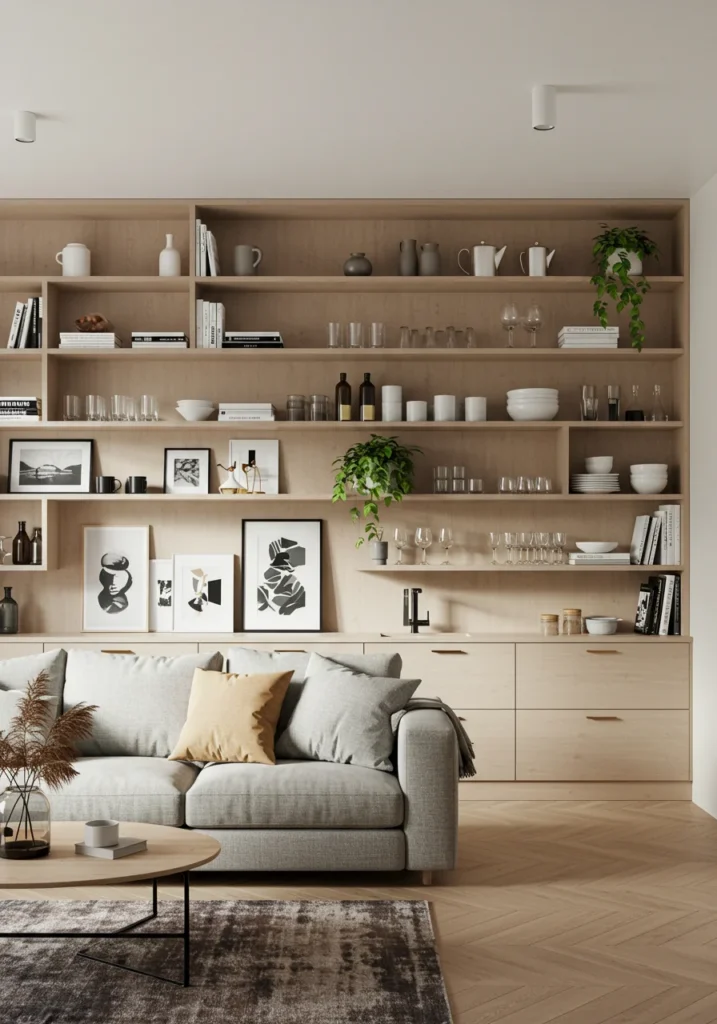
Open shelves are a versatile design element that seamlessly combines functionality with rustic charm, making them ideal for living rooms and kitchens. By providing accessible storage, open shelving allows homeowners to display their favorite dishes, decorative objects, or potted plants while keeping essentials within easy reach. Unlike closed cabinets, open shelves visually expand the space, creating an airy, open atmosphere that complements the warm, inviting feel of rustic interiors.
In kitchens, open shelves are particularly practical and stylish. They can showcase a collection of pottery, glassware, or vintage kitchenware, turning everyday items into decorative focal points. Natural wood shelves paired with metal brackets highlight the rustic aesthetic, while also providing durable support for heavier items. Arranging items thoughtfully—grouping by color, texture, or function—adds visual harmony and ensures the display feels curated rather than cluttered.
Living rooms benefit from open shelving as well, where they can hold books, framed photos, or small decorative accents. Incorporating woven baskets, rustic pottery, or greenery on these shelves further reinforces the cozy, textured vibe of the space. By layering items of different heights and textures, open shelving creates depth and interest, enhancing the overall warmth and character of the room.
Ultimately, open shelves are both practical and aesthetically pleasing. They blend rustic charm with functionality, providing storage, display, and a sense of openness that enhances the natural beauty of wood, stone, and other rustic materials. Thoughtfully styled, open shelves transform living rooms and kitchens into organized, inviting spaces that are both stylish and welcoming.
Rustic artwork addition
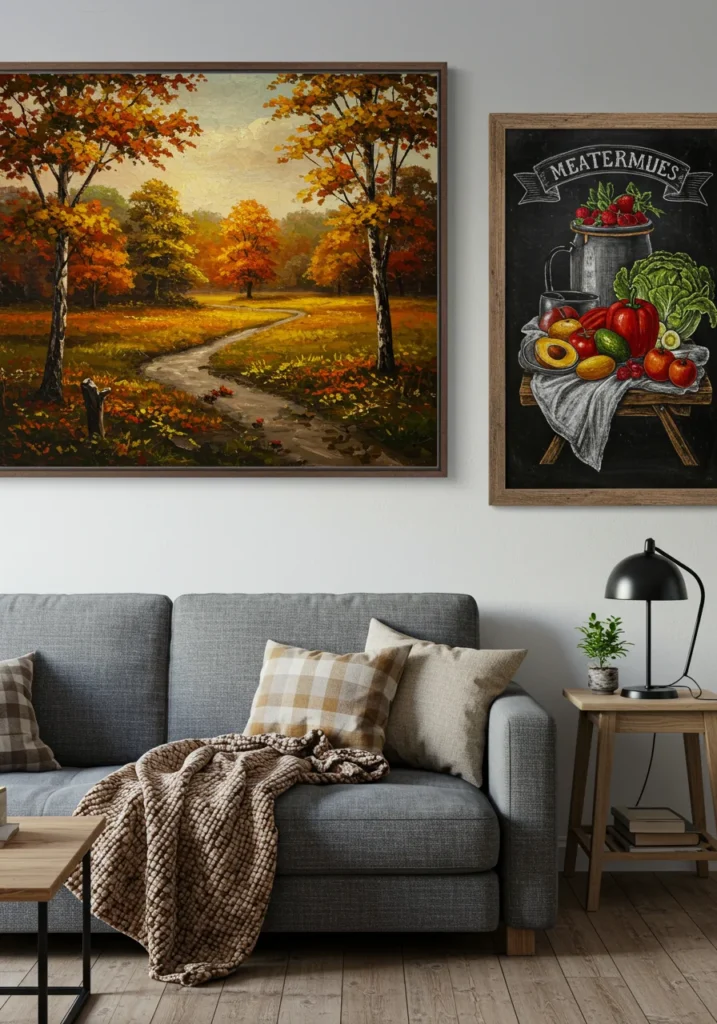
Rustic artwork is an effective way to bring personality, charm, and visual interest to living rooms and kitchens. By incorporating pieces that reflect natural elements, vintage aesthetics, or handcrafted artistry, homeowners can tie the overall décor together while reinforcing the rustic theme. Whether it’s a nature-inspired print, a vintage sign, or a wooden wall sculpture, rustic artwork introduces character and warmth, transforming blank walls into engaging focal points that complement the space.
In living rooms, rustic artwork can enhance the cozy, inviting atmosphere by adding layers of texture and color. A framed print of a forest scene, a distressed wooden sign, or a handcrafted sculpture on the wall above a console table or fireplace draws attention while harmonizing with wood tones, earthy rugs, and woven baskets. These pieces help create a sense of continuity, connecting furniture, textiles, and architectural features in a visually appealing way.
Kitchens also benefit from the addition of rustic art. Hanging vintage-inspired signage, botanical prints, or small wooden sculptures near countertops or open shelving adds charm and interest without overwhelming the space. Combined with stone backsplashes, wood cabinets, and copper or metal accents, artwork becomes an integral part of the room’s layered, textured aesthetic.
Ultimately, rustic artwork provides both functional and decorative value. It enhances warmth, character, and personality, helping to define the style of the room. Thoughtfully selected and positioned, these pieces complement earthy tones, natural textures, and other rustic elements, ensuring living rooms and kitchens feel cohesive, welcoming, and full of unique charm.
Unique Rustic pottery pop
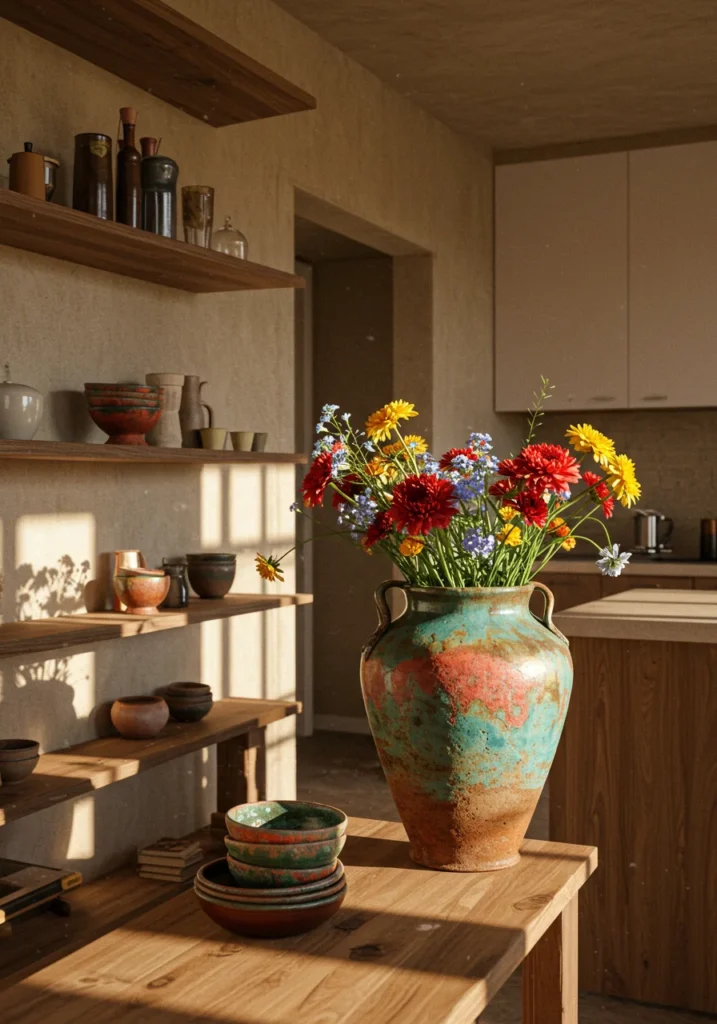
Rustic pottery is a versatile and timeless way to bring charm, texture, and warmth to living rooms and kitchens. Its earthy tones, handcrafted details, and unique, imperfect shapes create a sense of authenticity and personality in any space. Unlike mass-produced decor, rustic pottery carries a handmade quality that adds character and depth, making interiors feel thoughtfully curated and inviting. These pieces are ideal for both display and practical use, blending functionality with aesthetic appeal.
In living rooms, rustic pottery can be showcased on open shelving, mantels, or side tables. Bowls, vases, and small decorative pieces provide tactile interest and visual contrast, complementing wood furniture, woven baskets, and layered textiles. Grouping pottery pieces of varying heights, shapes, and finishes creates a dynamic arrangement that draws the eye and reinforces the cozy, lived-in vibe of the room.
Kitchens also benefit from rustic pottery’s warmth and versatility. Handmade mugs, pitchers, or serving bowls can be displayed on countertops or open shelving, adding both style and practicality. Earthy glazes and natural textures complement stone countertops, wood cabinetry, and metal accents, enhancing the overall rustic aesthetic.
Ultimately, rustic pottery brings a unique combination of beauty, character, and functionality to rustic interiors. By incorporating these handcrafted pieces, homeowners can create living rooms and kitchens that feel warm, inviting, and full of personality. The tactile textures, natural finishes, and imperfect charm of pottery ensure that every corner of the space reflects a cozy, authentic, and timeless style.
